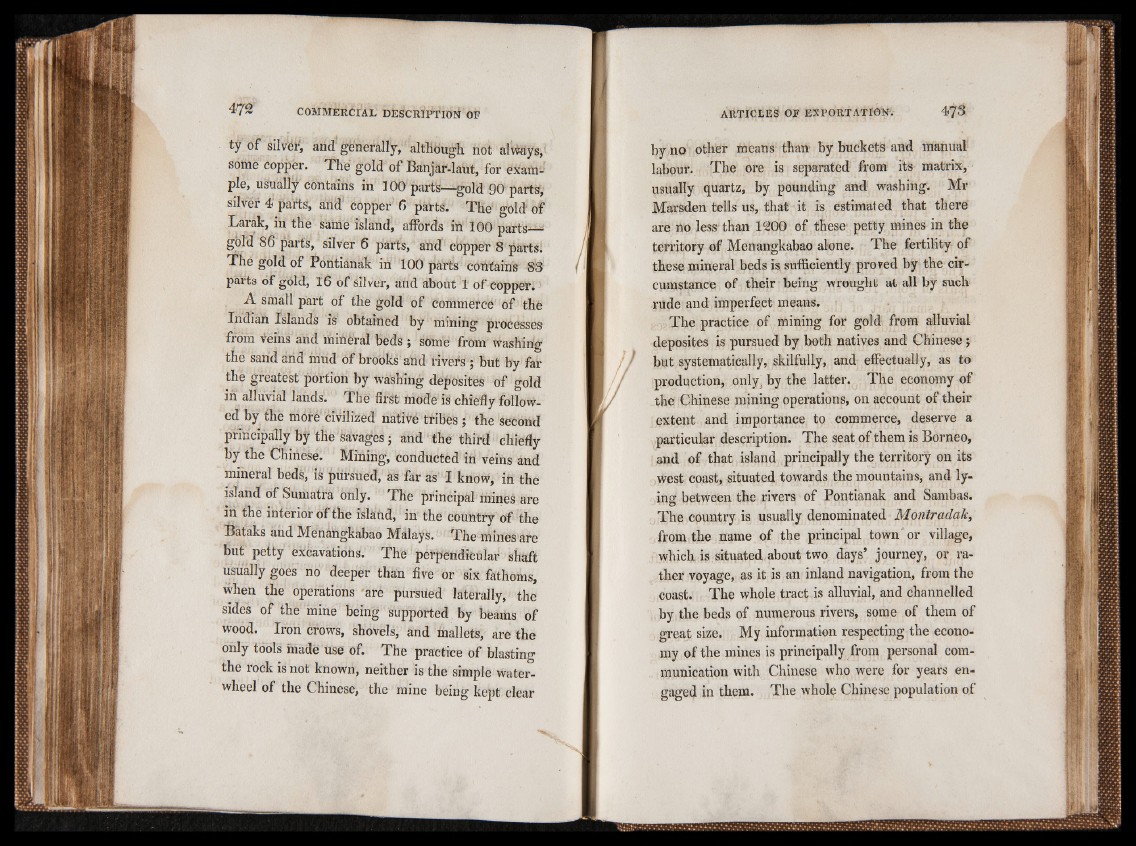
ty °f silver; and'generally, although not always,
soihë copper. The gold of Banjar-laut, for eXani-
ple, usually contains in 100 part's—gold 90 parts,
silver 4 parts, arid' còpper fi parts. The' gold of
Laràk, in thé same island, affords in 100 parts—
gold 86 parts, silver 6 parts, and cbpper 8 parts.
The gold of Pontianak id 100 parts contains 83
parts of gold, 16 of Silver, and about 1 of copper.
A small part of the gold of commerce of the
Indian Islands is obtained by mining processes
from Véins and mineral beds ; sòme from washing
the sand and mud of brooks and rivers ; but by far
the greatest portion by washing deposites of gold
in alluvial lands. Thè first mode is chiefly follow-
ed by thè mòre civilized natìvé tribes ; the second
principally by the Savages ; and thé third chiefly
by the Chinese; ' Mining, conducted in veins and
mineral beds, ÌS pursued, as far as I know, itt the
island of Sumatra only. The principal mines are
in thé infèrior of the island, in the country of the
Bafàks and Menângkabao Màlaÿs. The mines are
but petty excavations. The perpendicular shaft
usually goes no deeper than five or six fathoms,
when the operations 'arè pursued laterally, the
sides of the mine being supported by beams of
wood. Iron crows, shovels, and mallets, are the
only tools made Use of. The practice of blasting
the rock is not known, neither is the simple water-
wheel of the Chinese, the mine being kept clear
by no other means than by buckets and manual
labour. The ore is separated from its matrix,
usually quartz, by pounding and washing. Mr
Marsden tells us, that it is estimated that there
are no less than 1200 of these petty mines in the
territory of Menangkabao alone. The fertility of
these mineral beds is sufficiently proved by the circumstance
of their being wrought at all by such
rude and imperfect means.
The practice of mining for gold from alluvial
deposites is pursued by both natives and Chinese j
but systematically, skilfully, and effectually, as to
production, only, by the latter. The economy of
the Chinese mining operations, on account of their
extent and importance to commerce, deserve a
particular description. The seat of them is Borneo,
and of that island principally the territory on its
West coast, situated towards the mountains, and lying
between the rivers of O Pontianak and Sambas. The country is usually denominated Montradak,
from the name of the principal town'or village,
which is situated about two days’ journey, or rather
voyage, as it is an inland navigation, from the
coast. The whole tract is alluvial, and channelled
by the beds of numerous rivers, some of them of
great size. My information respecting the economy
of the mines is principally from personal communication
with Chinese who were for years engaged
in them. The whole Chinese population of